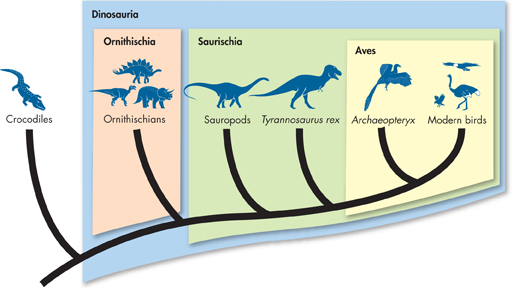
FIGURE 19–9 The Lineage to Modern Birds This cladogram shows some of the clades within the large clade Reptilia. Notice that clade Dinosauria is represented today by modern birds. Classify What are the two major clades of dinosaurs?
dAdaptation and Extinction Throughout the history of life, organisms have faced changing environments. When environmental conditions change, processes of evolutionary change enable some species to adapt to new conditions and thrive. Species that fail to adapt eventually become extinct. Interestingly, the rates at which species appear, adapt, and become extinct vary among clades, and from one period of geologic time to another.
Why have some clades produced many successful species that survived over long periods of time, while other clades gave rise to only a few species that vanished due to extinction? Paleontologists have tried to answer this question by studying macroevolutionary patterns of speciation and extinction in different clades over time.
One way to think about this process is in terms of species diversity. The emergence of new species with different characteristics can serve as the “raw material” for macroevolutionary change within a clade over long periods. In some cases, the more varied the species in a particular clade are, the more likely the clade is to survive environmental change. This is similar to the way in which genetic variation serves as raw material for evolutionary change for populations within a species.  If the rate of speciation in a clade is equal to or greater than the rate of extinction, the clade will continue to exist. If the rate of extinction in a clade is greater than the rate of speciation, the clade will eventually become extinct.
If the rate of speciation in a clade is equal to or greater than the rate of extinction, the clade will continue to exist. If the rate of extinction in a clade is greater than the rate of speciation, the clade will eventually become extinct.
The clade Reptilia (part of which is shown in Figure 19–9) is one example of a highly successful clade. It not only includes living organisms like snakes, lizards, turtles and crocodiles, but also dinosaurs that thrived for tens of millions of years. As you know, most species in the clade Dinosauria are now extinct. But the clade itself survived, because it produced groups of new species that successfully adapted to changing conditions. One of those groups survives and thrives today—we call them birds.

Table of Contents
- Formulas and Equations
- Applying Formulas and Equations
- Mean, Median, and Mode
- Estimation
- Using Measurements in Calculations
- Effects of Measurement Errors
- Accuracy
- Precision
- Comparing Accuracy and Precision
- Significant Figures
- Calculating With Significant Figures
- Scientific Notation
- Calculating With Scientific Notation
- Dimensional Analysis
- Applying Dimensional Analysis




